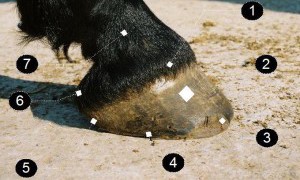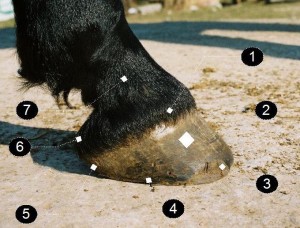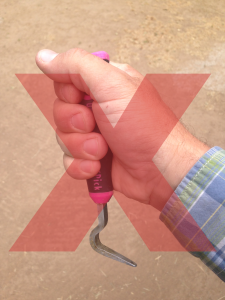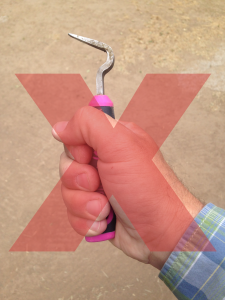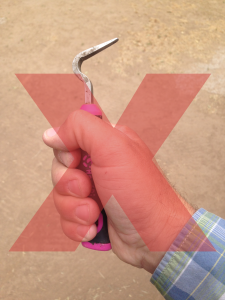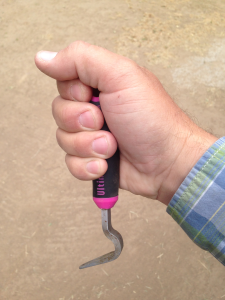Let me tell ya, picking a horse’s hooves is one incredibly important thing to do. And you can’t do it enough. Those feet are your only connection with the ground when you’re on your horse’s back so take good care of ’em. Doesn’t mater if your horse has shoes or is barefoot one of the most important things to do is pick their hooves. So . . . pick ’em as often as you can. Did I mention it’s important? Why is it important you ask? Well, by picking your horse’s hooves you get them used to having their legs and hooves handled, you get an idea of what they’re supposed to look like, you get the gunk out on a regular basis which will help fend off things like graveling, white line disease, abscesses, founder and thrush. Any one of those can mean the end of your horse’s hooves for a while if not a lifetime.
Take a look at the anatomy of the horse foot below. Here’s a great link to a more in-depth look at hoof anatomy.
Coronet band (1), walls (2), toe (3), quarter (4), heel (5), bulb (6), P2 (small pastern) (7)
 Very often I get a new student picking a hoof saying, “I don’t want to hurt her.” Usually I say something to the effect of, “She weighs one thousand pounds, don’t worry about it. Ferriers use knives to shape the frog so these dull picks won’t hurt her even if you try.” Basically, unless you really try . . . and you know where to push, you won’t hurt the horse. Cleaning and inspecting the hoof daily is incredibly important. Do it and do it often. If you focus on the collateral grooves on either side of the frog, you’ll get the most important areas cleaned quickly.
Very often I get a new student picking a hoof saying, “I don’t want to hurt her.” Usually I say something to the effect of, “She weighs one thousand pounds, don’t worry about it. Ferriers use knives to shape the frog so these dull picks won’t hurt her even if you try.” Basically, unless you really try . . . and you know where to push, you won’t hurt the horse. Cleaning and inspecting the hoof daily is incredibly important. Do it and do it often. If you focus on the collateral grooves on either side of the frog, you’ll get the most important areas cleaned quickly.
So, let’s get down to the basic how to of cleaning hoofs:
- Grab a hoof pick. There a million options. I have favorites, see my post on hoof picks for the best of the best here.
- How to hold the hoof pick: Upside down with he pick facing away. Don’t hold it any other way. Just don’t do it.
- Get a hoof picking pattern started. Horse’s like routines. Makes ’em feel good. I like to start with the front left, move to the back left, then front and back right. Doesn’t matter how you do it, just be consistent. Whatever works.
- With the front hooves, stand with your hip against their shoulder facing the rear of the horse, bend at your waist (don’t bend your knees, this can put you in a dangerous position) run your hand down their leg and lift the horse’s hoof up underneath them. If you have a horse that gives some resistance you can lift the hoof by pulling up on their fetlock and leaning into their shoulder to get their weight over to the other side. They need to have their weight over the opposite leg to be able to get their hoof off the ground so try to make sure they have their legs close together when you start. Note that the horse will keep his hoof curled up under them as long as they are comfortable, try to put as little pressure on their joints as possible as you left that hoof. If you pull the hoof out from under them off the to the side too far they will feel that pressure on their knee and most likely won’t cooperate quite as long. People usually pull the hoof off to the side and our from under the horse when they are feeling uncomfortable or scared around the horse’s hoves.
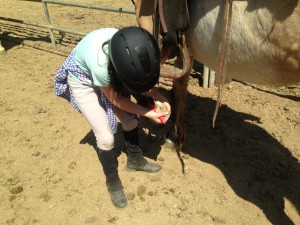
- Make sure you support the hoof with the hand you aren’t holding the hoof pick with. If you don’t support the actual hoof and you hold above the ankle you’ll put unneeded pressure on your horse’s joint and you won’t have a solid hoof to push into with your pick
- When you start picking the hoof it might be hard to see the anatomy of the hoof. It might be gunked up so much that you won’t be able to see anything. Start at the widest part of the hoof. Place the point of your pick into the collateral groove where it meets the back of the hoof. Push it in until you can’t push any more and drag it diagonally across the hoof. Look at the picture below. Clean out that groove. Just get the gunk out. Then move to the other side. Put it in and drag it diagonally across again.
- Then get the leftover stuff off the hoof wall. If your horse is barefoot, there probably won’t be much left after getting through those grooves but if you have shoes on, there might still be some left. Ferrier’s put nails through he hoof wall, so don’t worry about pushing too hard. You won’t hurt ’em. You’ll hurt ’em more if you don’t clean everything out.
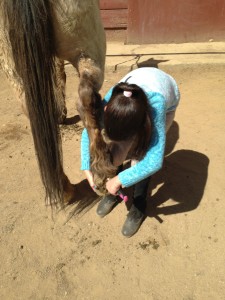 Back legs: They move different. Stand next to one, again facing the opposite direction of the horse’s face. Lift from the front side the hoof closest to the front hooves and push the hoof backwards away from he horse. Let the hoof naturally lift. Support the ankle with your hand and pick it like you did the front. You might have to bend over a bit further than you didon the front. Just do it.
Back legs: They move different. Stand next to one, again facing the opposite direction of the horse’s face. Lift from the front side the hoof closest to the front hooves and push the hoof backwards away from he horse. Let the hoof naturally lift. Support the ankle with your hand and pick it like you did the front. You might have to bend over a bit further than you didon the front. Just do it.- Couple of things to look for: Smell your hoof pick. If it smells really bad and not just poop bad but decay bad, you probably have some thrush. Thrush is the most common infection of the hoof but a horrid smell can be a symptom of something even worse. Treat it quick. Talk to your ferrier if you’re not sure what to do about thrush. There are a trillion options but basically you need to pick more often and keep them dry.
FYI below is a link to the hoof pick used in this post. The one mentioned in the video. It’s good. It’s expensive. But it’s good.
Great video about thrush. You should watch it.
Sometimes it’s hard to find good hoof reference material. Here is a great video about hooves and thrush (good stuff starts at 1:10). The playlist associated has a lot of good stuff too. It’s all about hooves! Hooves is a funny word. Say it ten times and you’ll feel silly…I always do.

